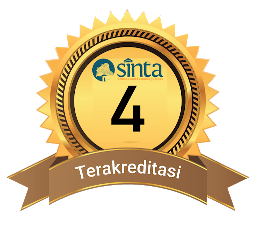Pengembangan LKPD Berbasis Inkuiri Terbimbing dan Instrumen Berpikir Kritis pada Pelajaran Kimia Materi Asam Basa
DOI:
10.29303/cep.v8i1.8191Published:
2025-05-31Issue:
Vol. 8 No. 1 (2025): Edisi MeiKeywords:
LKPD, inkuiri terbimbing, instrumen berpikir kritis, asam basaArticles
Downloads
How to Cite
Abstract
This research aims to develop guided inquiry-based LKPD and critical thinking instruments in acid-base chemistry lessons that are valid and practical. The research uses the R&D (Research and Development) method, a 4D development model which is carried out in only three stages (3D), namely Define, Design, and Develop. The results of the validity test using the Aiken's V index obtained a V value for the LKPD of 0.81 and for the instrument of 0.82, which shows that the LKPD based on guided inquiry and critical thinking instruments on acid-base material are very valid to use. The results of the practicality assessment of the LKPD and instruments showed that the average percentage of the LKPD was 88% and the instrument was 81%, which means that the LKPD based on guided inquiry and critical thinking instruments on acid-base material were very practical to use.Based on these data, it can be concluded that the guided inquiry-based LKPD and critical thinking instruments developed can be used in chemistry learning on acid-base material.
References
Andriani, M., Muhali., dan Dewi, C. (2019). Pengembangan Modul Kimia Berbasis Kontekstual untuk Membangun Pemahaman Konsep Siswa pada Materi Asam Basa. Jurnal Kependidikan Kimia, 7(1), 26-35.
Astawan, I. G., dan Agustina, I. G. A. T. (2020). Pendidikan IPA sekolah Dasar di Era Revolusi Industri 4.0. Bali: Nilacakra
Astuti, S., Danial, M., & Anwar, M. (2018). Pengembangan LKPD berbasis PBL (problem based learning) untuk meningkatkan keterampilan berpikir kritis peserta didik pada materi kesetimbangan kimia. Chemistry Education Review (CER), 1(2), 90-114.
Facione, P. A. 2015. Critical Thinking: What It Is and Why It Counts. In Insight assessment, 1(1), 3-7.
Hairani, G. R., & Setiawan, H. (2022). Pengembangan Lembar Kerja Peserta Didik Berbentuk Cerita Bergambar. Journal of Classroom Action Research, 4(1), 142-148.
Ikhwan, H dan Mawardi (2020). Pengembangan Lembar Kerja Peserta Didik (Lkpd) Berbasis Inkuiri Terbimbing Untuk Meningkatkan Keterampilan Berpikir Kritis Pada Materi Sifat Koligatif Larutan. Ranah Research: Journal of Multidisciplinary Research and Development, 2(4), 113-118.
Irsalina, A., dan Dwiningsih, K. (2018). Analisis kepraktisan pengembangan lembar kegiatan peserta didik (LKPD) berorientasi blended learning pada materi asam basa. Jurnal Kimia dan Pendidikan Kimia, 3(3), 171-182.
Jaya, T. D., Tukan, M. B., dan Komisia, F. (2022). Penerapan Pendekatan Inkuiri Terbimbing Untuk Melatih Keterampilan Proses Sains Siswa Materi Larutan Penyangga. Educativo: Jurnal Pendidikan, 1(2), 366-373.
Jiwandono, N. R. (2019). Kemampuan Berpikir Kritis (Critical Thinking) Mahasiswa Semester 4 (Empat) pada Mata Kuliah Psikolinguistik Ed-Humanistics: Jurnal Ilmu Pendidikan, 4(1).
Lovisia, E. (2018). Pengaruh Model Pembelajaran Inkuiri Terbimbing terhadap Hasil Belajar. Science and Physics Education Journal (SPEJ), 2(1), 1–10. https://doi.org/10.31539/spej.v2i1.333.
Margunayasa, I. G., Dantes, N., dan Marhaeni, A. A. I. N., dan Suastra, I. W. (2019). The Influence og Guided Inquiry Learning and Cognitive Style on Science Learning Achievement nternasiona:l Journal of Learning, 12(1), 738-739.
Retnawati, H. (2006). Validitas Reliabilitas dan Karakteristik (Panduan untuk Peneliti, Mahasiswa, dan Psikometri). Yogyakarta: Parama Publishing.
Sanjaya, W. (2010). Inovasi Kurikulum dan Pembelajaran: Teori dan Praktik Kurikulum Tingkat Satuan Pendidikan (KTSP). Jakarta: Kencana Prenada Media Group.
Sutresna, N. (2007). Cerdas Belajar Kimia. Bandung. PT. Grafindo Media Pratama.
Pranata, D. P., Frima, A., dan Egok, A. S. (2021). Pengembangan LKS matematika berbasis problembased learning pada materi bangun datar sekolah dasar. Jurnal basicedu, 5(4), 2284-2301.
Pratiwi, D. M., Saputro, S., Saputro, C., & Nugroho, A. (2015). Pengembangan LKS berbasis inkuiri terbimbing pada pokok bahasan larutan penyangga kelas XI IPA. Jurnal Pendidikan Kimia Universitas Sebelas Maret, 4(2), 32-37
Puspita, A., Kurniawan, A. D., dan Rahayu, H. M. (2017). Pengembangan Media Pembelajaran Booklet Pada Materi Sistem Imun Terhadap Hasil Belajar Siswa Kelas XI SMAN 8 Pontianak. Jurnal Bioeducation, 4(1).
Utami, F.V., Saputro, S., dan Susanti, E., (2020). Analisis Jenis dan Tingkat kesulitan belajar siswa kelas XI MIPA SMAN 2 SURAKARTA Tahun Pelajaran 2018/2019 dalam Memahami Materi Asam Basa Menggunakan Two Tier Multiple Choice. Jurnal Pendidikan Kimia, 9(1), 55-59.
Wijaya, C. (2010). Pendidikan remidial: sarana pengembangan mutu sumber daya manusia. Bandung: PT. Remaja Rosdakarya.
Yuniarni, D., Sari, R. P., dan Atiq, A. (2019). Pengembangan multimedia interaktif video senam animasi berbasis budaya khas Kalimantan Barat. Jurnal Obsesi: Jurnal Pendidikan Anak Usia Dini, 4(1), 280-294.
Author Biographies
Kintan Haiatul Maktun, Universitas Mataram
Mukhtar Haris, Pendidikan Kimia, FKIP, Universitas Mataram
Jeckson Siahaan, Program Studi Pendidikan Kimia, Universitas Mataram
License
Copyright (c) 2025 Kintan Haiatul Maktun, Mukhtar Haris, Jeckson Siahaan

This work is licensed under a Creative Commons Attribution-ShareAlike 4.0 International License.
Authors who publish with Chemistry Education Practice agree to the following terms:
- Authors retain copyright and grant the journal right of first publication with the work simultaneously licensed under a Creative Commons Attribution License 4.0 International License (CC-BY-SA License). This license allows authors to use all articles, data sets, graphics, and appendices in data mining applications, search engines, web sites, blogs, and other platforms by providing an appropriate reference. The journal allows the author(s) to hold the copyright without restrictions and will retain publishing rights without restrictions.
- Authors are able to enter into separate, additional contractual arrangements for the non-exclusive distribution of the journal's published version of the work (e.g., post it to an institutional repository or publish it in a book), with an acknowledgement of its initial publication in Chemistry Education Practice.
- Authors are permitted and encouraged to post their work online (e.g., in institutional repositories or on their website) prior to and during the submission process, as it can lead to productive exchanges, as well as earlier and greater citation of published work (See The Effect of Open Access).






